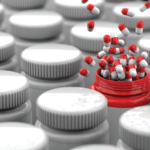Further, Chia et al. showed that colchicine was selective in inhibiting monosodium urate (MSU) induced superoxide production by neutrophils at much lower doses than those required to inhibit neutrophil migration in vivo.7 Nevertheless, neutrophils treated with colchicine were still able to mount superoxide production in response to stimuli other than MSU. Thus, the use of colchicine in the treatment of gout at low, non-toxic doses would have no impact on superoxide production by other stimuli.7
Colchicine exerts an additional anti-inflammatory effect by blunting tumor necrosis factor (TNF) α-induced activation of macrophages. It reduces TNF receptors on macrophage surfaces and may also have a role in inhibiting both cell-mediated immunity and antibody selection. It also inhibits the expression of IL-2 receptor on activated T lymphocytes and down-regulates ICAM-1 and E-selectin on endothelial cell surfaces, and induces shedding of neutrophil adhesion molecules L-selectin, which interfere with adhesiveness and further recruitment of neutrophils.
Finally, colchicine inhibits transforming growth factor β and directly suppresses specific genes, like fibronectin, thus giving colchicine antifibrotic properties.5
Colchicine is a relatively well-tolerated drug, with the most common side effect being diarrhea, which is noted in about 23% of patients receiving low to moderate doses.
Current Uses
Below, we discuss various off-label and novel applications of colchicine, in addition to reviewing the FDA-approved indications.
I. FDA-approved indications for the use of colchicine:8
A. Treatment of acute gout: Colchicine is an effective treatment for acute gout if used soon after initiation of the gout attack.9,10 It works well even when used at a lower dose, as described in the AGREE trial and is well tolerated at that dose.11 It can be safely used in patients with chronic kidney disease, which is a contraindication for the use of non-steroidal anti-inflammatory drugs (NSAIDs) in the treatment of gout; dose adjustment is necessary in such situations.12
B. Chronic prophylaxis against gout: Although the ACR recommends allopurinol, a xanthine oxidase inhibitor, as a typical drug for prophylaxis against future gout attacks, colchicine has two unique roles: 1) It can be used in conjunction with allopurinol until target serum uric acid levels are reached, and 2) colchicine can be used for chronic prophylaxis in individuals who are intolerant of uric acid lowering or have contraindications to allopurinol’s use.
C. Familial Mediterranean fever: Colchicine can be used at doses up to 2.4 mg/day in divided doses to treat this rare condition, which affects individuals of certain ethnicities, including Ashkenazi Jews, Italians, Greeks, Spaniards and Cypriots. It has also been approved in children with this condition.13
II. Non-FDA-approved indications for the use of colchicine:

